Discover the Amazing World of Sea Turtles
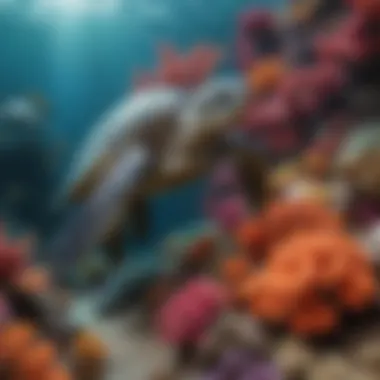
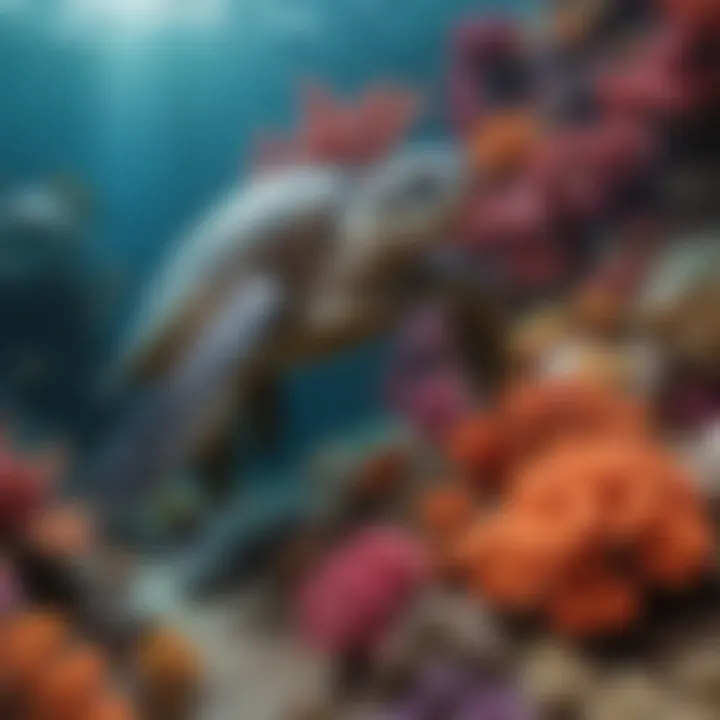
Nature Topic Overview
Sea turtles are fascinating creatures that have inhabited our oceans for millions of years. They are among the oldest reptiles on Earth and play a vital role in the marine ecosystem. This article explores the intriguing biology, habitat, and behavior of sea turtles while shedding light on their beauty and the importance of their conservation.
Understanding these creatures is essential for appreciating their role in maintaining balance within their environments. Sea turtles help maintain sea grass beds and coral reefs, contributing to the health of marine ecosystems.
Fun Facts and Trivia
- Sea turtles can hold their breath for several hours while swimming underwater. This is especially important when they are migrating long distances.
- The largest species of sea turtle is the leatherback turtle, which can weigh up to 2,000 pounds and can reach lengths of over six feet.
- Unlike many other turtles, sea turtles do not retract their heads into their shells. Their unique body structure allows them to glide efficiently through the water.
Did you know? Some sea turtles can live for more than 100 years, making them one of the longest-lived reptiles.
Incorporating visuals, such as pictures of different species and videos of their behaviors, can make learning about sea turtles much more engaging for young readers.
Wildlife Explorations
There are seven species of sea turtles, each with unique traits:
- Green turtle: Known for its herbivorous diet, feeding largely on seagrasses.
- Loggerhead turtle: Recognizable for its large head, which assists in cracking hard shells of prey.
- Hawksbill turtle: Has a beautiful shell and is often found in coral reefs, where it helps maintain reef health by feeding on sponges.
- Leatherback turtle: The only species without a hard shell and mainly feeds on jellyfish, helping control jellyfish populations.
These turtles inhabit various coastal and oceanic environments, from beaches to reefs. Understanding their habitats is key to appreciating their life cycle.
Environmental Awareness
Conservation of sea turtles is crucial. Many species are endangered due to habitat loss, pollution, and climate change. Learning why we need to protect these creatures helps everyone understand their importance.
Kids can help in various ways:
- Participate in beach clean-ups to keep nesting sites safe.
- Educate others on avoiding single-use plastics that can harm marine life.
- Support organizations focused on sea turtle conservation.
DIY Nature Activities
Engaging with nature is a wonderful way to learn. Here are some simple activities:
Turtle Craft
- Gather materials like paper, scissors, and crayons.
- Cut out a turtle shape and color it.
- Create a habitat scene using construction paper and other materials.
Nature Walk
Take a walk at a nearby beach or park and look for signs of wildlife. Kids can create a journal to document what they find, followed by research about the species they encounter.
By participating in these activities, young readers can deepen their understanding and appreciation of sea turtles and their habitats. Encouraging outdoor explorations enhances learning and fosters a sense of responsibility towards nature.
Preamble to Sea Turtles
The topic of sea turtles is important for understanding marine life and its diverse ecosystems. These creatures are not only intriguing but also play a vital role in maintaining the health of ocean environments. Sea turtles have existed for millions of years, demonstrating remarkable adaptations to their habitats. Learning about them fosters an appreciation of nature and awareness of environmental challenges.
Sea turtles are fascinating mainly due to their life cycles and behaviors. Their long migrations across oceans showcase their reliance on different habitats for feeding, resting, and nesting. The conservation of sea turtles is another aspect that we should consider, as human activities significantly impact their populations. Educating children and adults about these magnificent creatures encourages conservation efforts and sustainability.
Physical Characteristics
Physical characteristics of sea turtles are both fascinating and crucial for understanding these creatures. Analyzing their structure allows us to appreciate their adaptations to marine life. Their shells, limbs, and other features contribute significantly to their survival and success in the ocean. They show how effective their design is for swimming, protection, and even reproduction.
Shell Structure and Function
Carapace
The carapace is the upper shell of a sea turtle and is an essential part of its anatomy. It serves as a protective shield against predators and hazards. A unique characteristic of the carapace is its hard and streamlined shape. This design helps reduce drag while swimming, making it easier for the turtle to move through water. The carapace is also made of bony plates that provide durability.
One limitation is that, unlike some mammals, sea turtles cannot retract their heads or limbs into their shells. Therefore, while the carapace offers protection, it does not give complete security from threats.
Plastron
The plastron is the lower shell that complements the carapace. It plays an important role in protection as well but also serves other functions. One key characteristic of the plastron is its flatter shape, allowing the turtle to stay close to the ocean floor. This feature aids in camouflage against potential predators. Another advantage is that it helps in buoyancy control.
Despite its solid structure, the plastron can be susceptible to injuries from human activities, such as fishing or boating. Therefore, its protection is important for the turtle's overall health.
Scutes
Scutes are the bony plates on the outer layer of the shell, both on the carapace and plastron. They are critical for the overall health of sea turtles. Each species has a distinct arrangement and number of scutes. Their primary function is to protect the underlying bones and tissues.
A notable aspect of scutes is that they can provide indications of a turtle’s age. As a turtle matures, its scutes may show wear and growth rings. However, a disadvantage is that scutes can also be affected by pollution or physical damage, impacting the turtle's health.
Unique Adaptations for Marine Life
Flippers and Swimming Ability
Sea turtles have adapted uniquely to life in the ocean with their powerful flippers. These limbs are essential for their swimming ability. A key characteristic of their flippers is the large surface area, which propels them efficiently through water. These flippers are also shaped to help in navigating currents and tides effortlessly.
While powerful, the flippers can be stiff, making them less effective on land. They are specifically designed for aquatic movement.
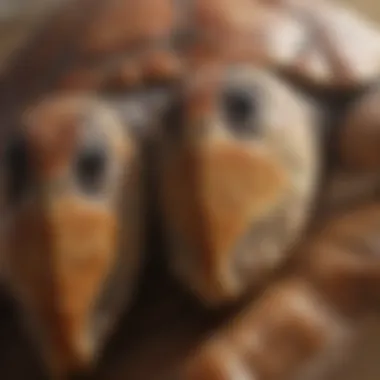
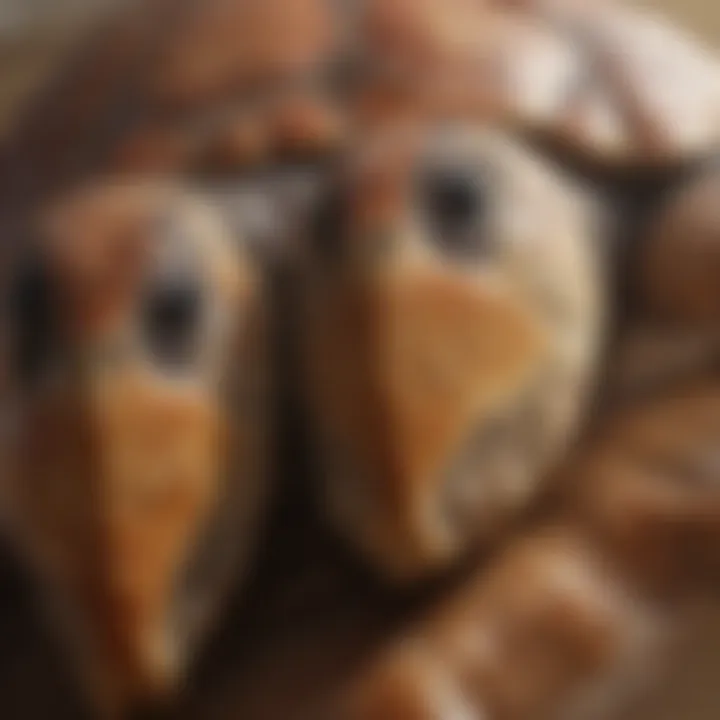
Temperature Regulation
Temperature regulation is another important adaptation for sea turtles. These reptiles are ectothermic, meaning they rely on environmental temperatures to regulate their body heat. One key aspect of their adaptation is the ability to adjust their behavior to seek warmer or cooler waters, depending on their needs.
This regulation is beneficial for maintaining metabolism. However, it also makes them vulnerable to climate change, which can alter their habitats drastically.
Habitat and Distribution
Understanding the habitat and distribution of sea turtles is essential for comprehending their survival and role in marine ecosystems. Sea turtles inhabit diverse environments ranging from coastal areas to the vast open ocean. Each of these habitats presents unique features that support the life and behaviors of these reptiles.
Where Do Sea Turtles Live?
Coastal Areas
Coastal areas serve as critical habitats for sea turtles. These regions provide essential nesting sites where adult female turtles come ashore to lay their eggs. The sandy beaches of coastal areas are a preferred choice for nesting because they offer a dry environment that protects eggs from tidal waves and predators.
Additionally, coastal waters are rich in seagrass and algae, which are important food sources for many species. The proximity of these food resources means turtles can easily access them while also maintaining a safe distance from deep ocean predators. Thus, coastal habitats support the reproductive cycle and feeding habits of sea turtles.
Key Characteristics of Coastal Areas:
- Provide safe nesting sites.
- Rich in food sources like seagrass.
- Offer protection from predators.
This habitat is beneficial but has disadvantages, too. Coastal areas face threats from human activities, such as development and pollution, which can disrupt the delicate balance necessary for these turtles to thrive.
Open Ocean
The open ocean is another major habitat for sea turtles. Unlike coastal areas, which offer shelter and nesting sites, the open ocean provides vast, uncrowded spaces where turtles can roam freely. Some species, like the leatherback turtle, are known for their long-distance migrations across the ocean.
Key Characteristics of Open Ocean:
- Provides ample space for long migrations.
- Suitable for hunting jellyfish and other prey.
One unique feature of the open ocean is its role in the life cycles of sea turtles. Research has shown that certain species depend on this environment for feeding, as they can encounter rich feeding grounds that support their growth. However, the open ocean also presents challenges. Strong currents and a lack of safe havens can make it difficult for turtles to navigate and evade predators.
Migration Patterns
Migration is a significant behavior observed in many sea turtle species. Understanding the reasons and distances involved in their migrations is key to appreciating their life cycle.
Reasons for Migration
Sea turtles migrate for various reasons. One primary factor is to find suitable nesting areas. Among the many populations, females travel long distances to return to their birthplace, where they nest. In addition, they may migrate to reach warmer waters rich in food, especially during colder months.
This behavior ensures the survival of sea turtles by optimizing their access to food and safe nesting sites. Migration is beneficial as it helps maintain the genetic diversity within the species and supports the health of marine ecosystems.
Key Features of Migration Reasons:
- Ensures safe nesting.
- Optimizes food resource access.
These migrations also highlight the interconnectedness of marine ecosystems, demonstrating how turtles rely on various habitats to complete their life cycles.
Distance Traveled
The distances sea turtles travel can be quite impressive. Some species can migrate thousands of miles. For instance, the leatherback sea turtle has been tracked traveling from the South American coast to the waters of Alaska. These long journeys allow turtles to find food, mate, and nest in suitable environments.
Key Characteristics of Distance Travelled:
- Leatherbacks may travel thousands of miles.
- Distances vary by species and individual.
However, the considerable distances can expose turtles to various threats such as boat strikes and fishing gear entanglement. This underscores the need for conservation efforts that safeguard migration routes and habitats that are critical to their life cycles.
Diet and Feeding Habits
Diet and feeding habits play a significant role in the overall health and behavior of sea turtles. Understanding what these creatures eat helps us appreciate their role in marine ecosystems. Their diets influence not only their own survival but also the health of other marine life. Healthy feeding habits ensure the balance of underwater habitats, making sea turtles an essential part of oceanic ecosystems.
Types of Food Sea Turtles Eat
Sea turtles are generally categorized based on their dietary preferences into herbivorous and carnivorous species.
Herbivorous Species
Herbivorous sea turtles, like the Green Turtle, primarily consume marine plants such as seagrass and algae. These turtles help maintain the health of seagrass beds which are crucial for marine life. By grazing on seagrass, they prevent overgrowth, allowing sunlight to reach the seabed for other plants. This characteristic contributes substantially to their habitat's health, making them a key player in nutrient cycling.
Unique Feature: Their specialized jaws allow them to efficiently graze on tough plant material.
Advantages: Their feeding habits support the marine ecosystem. Their role in maintaining seagrass beds helps stabilize coastlines and provides homes for many marine organisms.
Carnivorous Species
Carnivorous species, such as the Loggerhead Turtle, consume a diet rich in jellyfish and crustaceans. Their diet plays an important role in controlling jellyfish populations. A healthy population of Loggerhead Turtles can help balance the ecosystem by preventing jellyfish blooms, which can be harmful to fish populations.
Unique Feature: They have strong jaws that enable them to crush hard shells of prey like crabs and mollusks.
Advantages: By keeping jellyfish numbers in check, they contribute to a balanced marine food chain and help maintain biodiversity in their environment.
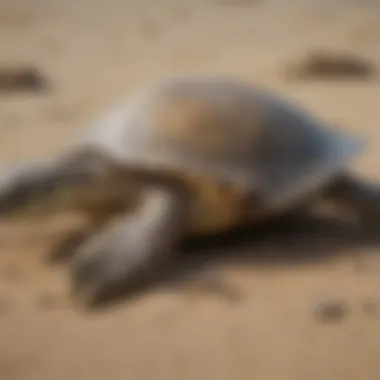
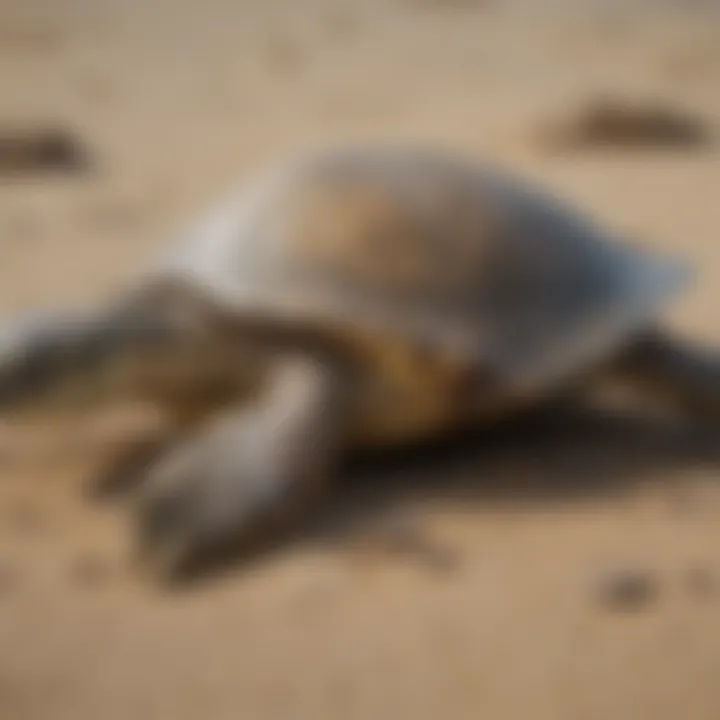
Feeding Techniques
Sea turtles have developed unique techniques for obtaining their food, which further demonstrates their adaptability in marine life.
Jellyfish Consumption
Jellyfish consumption is a significant trait for many sea turtles. They are particularly drawn to jellyfish due to their abundance in the ocean. Eating jellyfish allows these turtles to consume a high-water content food source, which is beneficial for hydration.
Key Characteristic: Some species have evolved to digest jellyfish, which other marine creatures may avoid due to stinging cells.
Advantages: The ability to eat jellyfish benefits sea turtles during times when other food sources are scarce, contributing to their survival.
Sea Grass Grazing
Sea grass grazing is another important feeding technique. Herbivorous turtles spend a lot of time grazing on seagrass beds. They play a vital role in maintaining these ecosystems through constant grazing. By doing so, they keep the grass healthy and promote growth.
Key Characteristic: They use their strong jaws to uproot and consume seagrass.
Advantages: This technique not only provides them with nutrition but also benefits the entire marine environment by promoting biodiversity.
Sea turtles are not just passive inhabitants of the sea; their feeding habits actively shape their environment. Understanding their diets helps clarify their role in marine ecology.
Reproduction and Life Cycle
The reproduction and life cycle of sea turtles are crucial for the survival of these magnificent creatures. Understanding these aspects helps us appreciate their complexities and the threats they face. Sea turtles display remarkable behaviors when it comes to nesting and hatching. This not only influences their survival rates but also the overall health of marine ecosystems. The successful completion of their life cycle ensures future generations continue to thrive.
Nesting Behavior
Selecting a Nesting Site
Selecting a nesting site is one of the first essential steps for a female sea turtle. This choice can significantly influence the success of her offspring. Sea turtles prefer sandy beaches in coastal areas. The warmth of the sand is crucial; it contributes to the temperature regulation of the developing eggs. Importantly, they often return to the same beach where they were born. This behavior is called natal homing.
A key characteristic of selecting a nesting site is its protection from tides and predators. Beaches that have vegetation provide cover and help shield the nests from strong waves and hungry animals. However, urban development poses threats, making some otherwise ideal sites less safe. The choice of nesting site is both a survival strategy and an evolutionary trait that supports the continuity of their species.
Egg-Laying Process
The egg-laying process is another vital component of the sea turtle's reproduction. After selecting a safe nesting site, the female turtle digs a hole in the sand. This hole is called a nest. She then carefully lays her eggs in this nest, which can contain about 100 eggs, depending on the species. The process can take several hours and requires much energy.
The unique feature of the egg-laying process is the careful concealment of the nest. Once all eggs are laid, she covers them with sand, hiding them from predators. This process ensures the eggs remain undisturbed until they hatch. However, the eggs are still vulnerable to environmental factors such as temperature and moisture. A successful egg-laying process leads to a higher hatch rate, which is vital for the survival of the species.
Hatching and Early Life
Egg Incubation
Egg incubation is a critical period in the life cycle of sea turtles. After the female lays her eggs, a significant incubation period begins, lasting between 45 to 70 days. The temperature of the sand where the eggs are buried directly impacts their development. Warmer sands generally produce female hatchlings, while cooler sands lead to males. This aspect emphasizes the importance of stable environmental conditions for successful hatching.
Egg incubation also faces risks from predators and natural elements. If the eggs are not well hidden or are exposed to flooding, their chances of survival decrease drastically. Therefore, a successful incubation period is key to ensuring that hatchlings emerge from their eggs and start their journey into the ocean.
Hatchling Survival
The moment hatchlings emerge from their eggs marks a critical phase in their lives. This phase comes with great challenges. Upon hatching, they instinctively head towards the ocean. The journey to the water is perilous. Many hatchlings fall prey to birds and other predators during this first sprint.
An important aspect of hatchling survival is the imprinted memory of the beach they were born on. This memory will guide them back in the future when they are ready to nest. Additionally, factors like light pollution can disorient hatchlings, leading them away from the water. Ensuring a safe environment for hatchlings is critical, as their survival rates are often very low.
"Only about one in a thousand sea turtles survive to adulthood."
Ecological Importance
Understanding the ecological importance of sea turtles is vital in comprehending their role within marine environments. Sea turtles contribute significantly to the health of ocean ecosystems. Their presence affects various ecological processes, offering benefits not just to themselves, but also to numerous other marine species and habitats.
Role in Marine Ecosystems
Maintaining Healthy Seagrass Beds
Sea turtles help in maintaining healthy seagrass beds, which are essential for many marine creatures. They graze on seagrass, which prevents it from overgrowing and creates a balanced underwater ecosystem. This also allows light to reach the lower levels of the seagrass beds, promoting growth. Healthy seagrass beds provide habitat for species such as fish and shrimp, acting as nurseries for many young marine animals.
Key Characteristics of Healthy Seagrass Beds:
- Biodiversity: Supports various marine species.
- Erosion Control: Protects coastlines from erosion.
- Oxygen Production: Contributes to oxygen levels in the water.
While grazing on seagrass is beneficial, overgrazing can lead to negative effects. It is important to maintain a balance to protect these vital ecosystems.
Supporting Marine Food Chains
Sea turtles play a crucial role in supporting marine food chains. They are both prey and predators within their ecosystems. As they consume jellyfish and other organisms, they help control populations, ensuring that no single species dominates the ecosystem. This balance is essential for preserving biodiversity.
Key Characteristics of Supporting Marine Food Chains:
- Predator-Prey Dynamics: Maintains healthy populations of species.
- Nutrient Cycling: Contributes to nutrient flow in the ocean.
These dynamics illustrate the interdependence of species in marine environments. When the balance is disrupted, it can lead to significant ecological consequences.
Interactions with Other Species
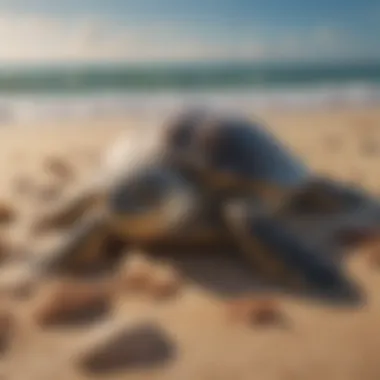
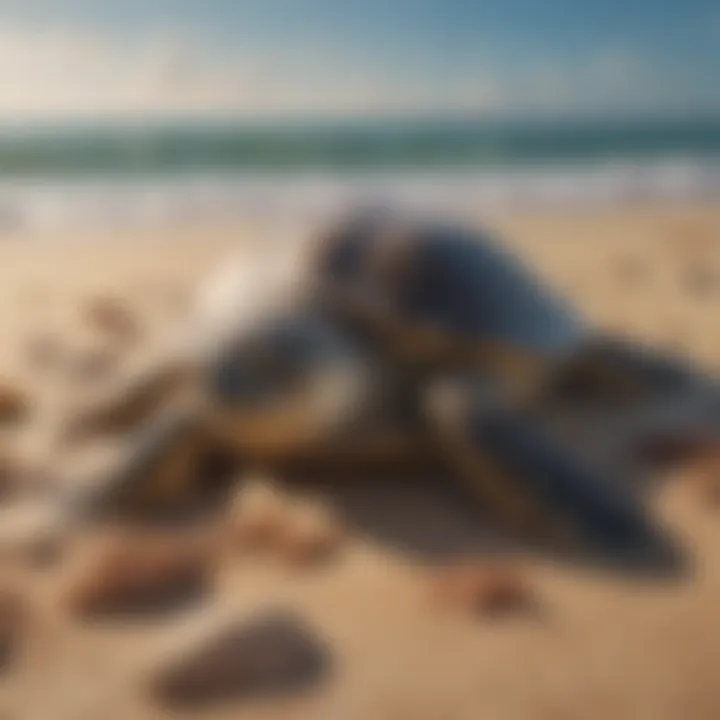
Predators and Prey
Sea turtles exist within a complex web of predators and prey. They often fall prey to natural predators like sharks, while at the same time they play a critical role as prey for larger species. This interaction is essential in maintaining population dynamics within the ocean.
Key Characteristics of Predators and Prey:
- Ecological Balance: Keeps various species populations in check.
- Food Supply: Provides energy flow between different levels of the food chain.
Despite these interactions being natural, factors such as human interference can alter predator-prey relationships, leading to ecological imbalances.
Mutualistic Relationships
Mutualistic relationships are crucial for sea turtles and other marine species. For example, some fish benefit from cleaning parasites off sea turtles. This interaction is mutually beneficial as it helps the fish find food while providing the turtles with a clean shell.
Key Characteristics of Mutualistic Relationships:
- Cooperation: Species work together for better survival.
- Energy Transfer: Helps sustain various organisms within the ecosystem.
These relationships further enhance the interconnectedness of marine life, showing how every creature, from the smallest fish to the largest sea turtle, plays a role in the ocean's ecological framework.
Threats to Sea Turtles
The survival of sea turtles faces many threats, with both natural and human-driven factors contributing to their decline. Understanding these threats is crucial for the future conservation efforts aimed at preserving these remarkable animals. The impact of human activities, habitat loss, and competition with other species highlights the intricate relationship between sea turtles and their environment.
Human Impact
Pollution
Pollution is one of the most significant threats to sea turtles. Oceans are filled with harmful debris, such as plastic bags and fishing nets, which can be ingested by turtles or entangle them. Notably, the presence of microplastics can disrupt their health, affecting their ability to feed and reproduce. A key characteristic of pollution is its ability to travel vast distances, impacting marine life far from the original source. This makes pollution a relevant topic in discussing sea turtles, as it showcases the broader implications of ocean health on these reptiles. A unique feature of pollution is its persistence in the environment, leading to long-term hazards for sea turtles and other marine creatures.
Climate Change
Climate change adds another layer of challenges for sea turtles. One major aspect is the rising temperatures, which influence nesting sites and temperature-dependent sex determination in hatchlings. Warmer beaches can produce more female turtles, upsetting the sex ratio necessary for reproduction. This topic is essential for understanding how global climate issues directly affect sea turtle populations. The unique feature of climate change lies in its gradual but severe effects, which can lead to habitat loss and altering ocean currents, thus impacting migration routes.
Fishing bycatch
Bycatch refers to the unintended capture of sea turtles in fishing gear. Such incidents occur when turtles become ensnared in nets or caught on fishing lines. This poses a serious threat, as it results in injuries or fatalities for countless turtles each year. A particular aspect of bycatch is its preventability; solutions such as Turtle Excluder Devices exist but are not universally implemented. Addressing bycatch issue is beneficial for marine ecosystems as it encourages sustainable fishing practices, which can restore balance in the environment.
Natural Predators
Sharks
Sharks are natural predators of sea turtles, introducing a significant biological balance in marine ecosystems. They often prey on smaller and weaker turtles, which can help in maintaining the overall health of the turtle population. A distinct feature of sharks is their role as apex predators; they help to control the population sizes of various species, including sea turtles. This fact makes sharks an integral part of the discussion regarding sea turtle conservation since protecting shark populations is essential for sustaining marine ecosystems.
Birds
Birds, particularly certain seabird species, represent another set of natural predators for hatchling sea turtles. As hatchlings emerge, many fall prey to hungry birds before they reach the safety of the water. Understanding the role of bird predation can help explain the low survival rates of sea turtles in their early life stages. Furthermore, birds also contribute to the nutrient cycle in the ocean, showing their ecological importance. However, their predation poses a disadvantage as it adds to the challenges sea turtles face right from the start.
Conservation Efforts
Conservation efforts for sea turtles are of utmost importance in ensuring their survival. Sea turtles face numerous threats, from human activities to natural predators. Effective conservation strategies help to protect these animals, their habitats, and the overall health of marine ecosystems. It is critical to promote awareness and understanding of the factors endangering sea turtles, as well as to highlight positive actions that can be taken to mitigate these threats.
International Treaties and Regulations
CITES
The Convention on International Trade in Endangered Species of Wild Fauna and Flora, known as CITES, plays a vital role in protecting sea turtles. This treaty aims to ensure that international trade does not threaten the survival of species. Sea turtles are listed under CITES Appendix I, which includes species that are threatened with extinction and are prohibited from international commercial trade. The key characteristic of CITES is its legally binding framework for member countries. This makes it a beneficial choice for this article, as it provides a foundation for cooperative international efforts to conserve sea turtles. A unique feature of CITES is its emphasis on monitoring trade. This helps to prevent over-exploitation and contributes to the preservation of sea turtle populations. However, one disadvantage is that enforcement varies among countries, leading to inconsistent outcomes.
Endangered Species Act
The Endangered Species Act (ESA) is crucial for the protection of sea turtles in the United States. This act provides for the conservation of species that are at risk of extinction. The ESA designates critical habitats for sea turtles, which are essential for their survival. A key characteristic of the Endangered Species Act is its proactive approach to recovery plans, which outline steps needed to aid in the recovery of endangered or threatened species. This makes it a beneficial choice for this article, emphasizing a structured method to save sea turtles. The unique feature of ESA is its potential for collaboration between government agencies and communities, enhancing the chances for successful outcomes. However, some argue that it may face challenges due to political and resource limitations.
Community Involvement and Education
Local Conservation Projects
Local conservation projects are essential in protecting sea turtles by engaging communities directly in conservation efforts. These projects often involve beach clean-ups, nesting protection, and habitat restoration, all contributing to healthier environments for sea turtles. A key characteristic of local conservation projects is their grassroots approach, fostering community ownership and responsibility. This makes them a popular choice for this article, as they demonstrate how local actions can have a global impact. The unique feature of these projects is the ability to adapt to specific local needs and conditions. However, funding and resources can be a challenge for maintaining and expanding these initiatives.
Creating Awareness
Creating awareness about sea turtles and their conservation needs is vital. Education campaigns can significantly influence public attitudes and behaviors towards marine life. A key characteristic of creating awareness is its ability to reach a wide audience, including schools, communities, and online platforms. This makes it a beneficial choice for this article, as it highlights the importance of knowledge-sharing in conservation efforts. A unique feature of awareness campaigns is their interactive methods, such as social media, which engage young people and promote activism. Nevertheless, one disadvantage is that misinformation can spread easily, making it critical to provide accurate and reliable information.
The End
Understanding the future of sea turtles and the ongoing efforts to protect them is crucial for maintaining marine biodiversity. As threats such as climate change and pollution persist, the survival of these reptiles hangs in the balance. The information presented in this article reflects not only the fascinating biology and ecology of sea turtles but also emphasizes the urgent need for concerted conservation efforts.
In exploring the complexities of their lives, from nesting behaviors to migratory patterns, we discover the intricate relationships these animals have with their environments. Each fact contributes to a broader narrative about the interconnectedness of life in the oceans. Raising awareness of these creatures not only highlights their importance in marine ecosystems but also urges us to act.
The Future of Sea Turtles
The future of sea turtles remains uncertain. These creatures face various challenges that could impact their populations and habitats. Conservation efforts are in place, but they require support from individuals and communities worldwide. By fostering policies that protect nesting sites and reduce plastic pollution in oceans, we can significantly alter the course of their future. Moreover, continued research is vital to understand the evolving threats they encounter and devise innovative solutions to combat them.
Encouraging Young Environmentalists
Engaging children in environmental education is essential for fostering the next generation of conservationists. Encouraging young environmentalists can happen in simple but effective ways.
- Hands-on Activities: Activities like beach clean-ups or sea turtle habitat restorations can create a direct connection between children and the ocean.
- Educational Programs: Schools can introduce programs that teach about marine biology and conservation.
- Use of Multimedia: Books, documentaries, and games centered around sea turtles can make learning fun and informative.
By nurturing this interest, we are not only educating them about sea turtles but also instilling a sense of responsibility towards our planet. Young minds can advocate for these creatures, ensuring their survival for generations to come.







